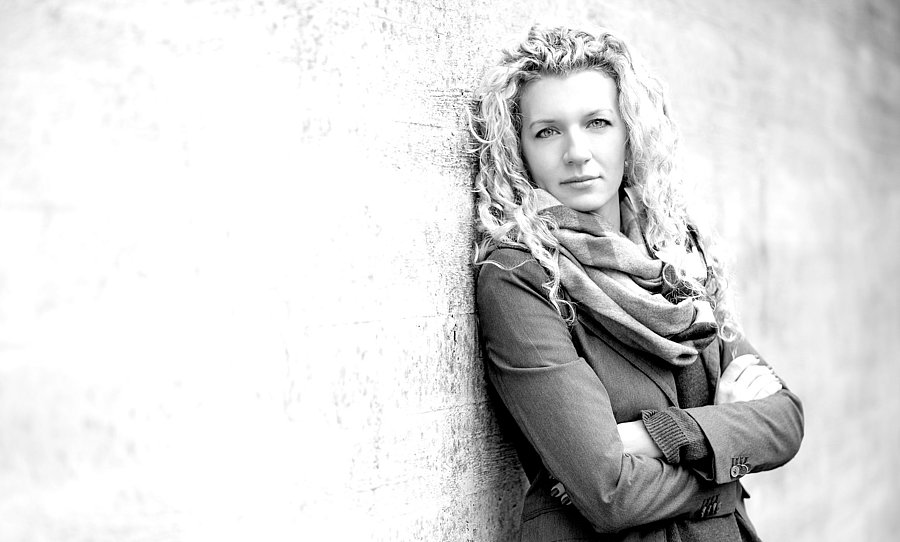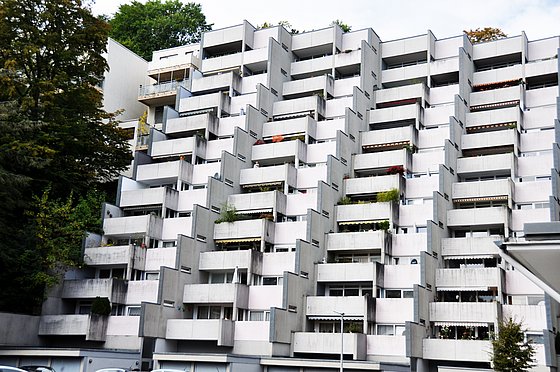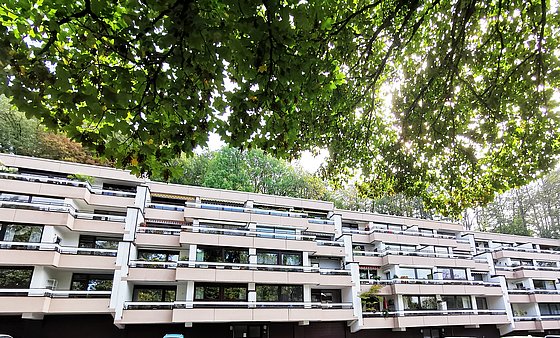
Dr. Uta Gelbke / Architecture
Photo: Pixstudios Zürich
Slope following or slope forming: The history of the terraced houses
Dr. Uta Gelbke on the diagonal living of post-war modernism
In the 1960s, they were the new form of living per se: terrace houses. The terraces are very similar to the gardens of single-family houses and on the ground floor level you do not stand in front of a vertical wall, but in front of an often greened slope. Dr. Uta Gelbke, architect at the Chair of Building with Existing Contexts, and Building Construction of Prof. Georg Giebeler, knows the story of the terraces.
"Terraced living is a development in the history of architecture. Such step-like constructions can be traced back to antiquity," explains the Berlin-born architect, referring to the Egyptian pyramids or the Tower of Babel. At the beginning of the 20th century, this type of architecture increasingly came back into the consciousness of renowned architects such as Adolf Loos or Le Corbusier, who were concerned with the possibility of terraced residential buildings and produced their first designs. "In the 1920s, Henri Sauvage in Paris, for example, was already designing residential buildings with a stepped, receding front," says Gelbke, who has been working on a research project to investigate the history of these special buildings.
Housing shortage in the post-war period
The housing shortage of the post-war period was the actual impulse for the construction of terraced buildings, the implementation of which was initially carried out in Switzerland. As the scientist explains: "At that time, a real boom for terraced buildings began in Switzerland. An answer to the housing shortage was needed and at the same time a large number of still undeveloped hillside premises were available in central locations. It was a good idea to use them. In addition to residential buildings, office buildings and public buildings, such as schools, were designed as staggered hillside houses. This new form of living then also appears in Germany with a time lag". The years between 1965 and 1980 are considered the blooming period of the terraced houses in Germany. It was during this period that most of the publications appeared that Gelbke collects and analyzes together with a small team of students. "It is interesting to note that in addition to these hillside buildings in Switzerland, there were also experiments conducted in Germany with the type of terrace house that are on the flat surface." Thus, a kind of offshoot was created that implemented the possibilities of terrace construction on a flat surface. "This favored further development and spread, because it was not possible to fall back on mountainous hillside locations nationwide," explains Gelbke, "and a lot of potential was seen in this building typology, for living, as well as for urban development.
Terrace house reconstruction leads to research project
A reconstruction project, for which the architect was responsible, led to the idea of offering a research project entitled "Living in the Hill - Terraced Houses of the 1960s and 70s as a form of building and living" for university teachings. "Together with my colleagues, I converted a terraced house in Oldenburg. The object corresponds exactly to the type of terraced house on the flat surface, an artificially created slope, in which the building is stepped on the south side and therefore wider at the bottom than at the top," explains Gelbke. The focus of her investigations was on the open spaces, the layout and the residents.
By open spaces, she especially considers the private outdoor spaces that are created by projections and recesses on the front and offer protection from insights. "The exterior space, i.e. the terraces, thus acquire the quality of a private home. Having enough space for private use is always an argument in favor of the single-family home. This can be offered here in a similar form, without provoking the same land consumption. The premises can be used more efficiently through this form of construction and the land costs for the individual can be reduced."
The floor plan layout of the Oldenburg project was also a particular challenge. Terraced houses are often designed in bulkhead construction, i.e. load-bearing walls divide the building in transverse direction with even spacing. This is exciting in the rearrangement of the floor plan in conversion projects. Apart from existing installations, the floor plan can be changed at will. And then there were the people, some of whom had lived there since the building was completed in 1970. "This suggests that there is a high quality of living that is so satisfying even in different phases of life that it does not necessarily require a move. And in the research carried out as part of the project at the university this has been confirmed on a random basis". In co-operation with the University of Stuttgart it would like to develop in addition a sociological study of 1973, which examined the satisfaction of terrace house inhabitants in Hamburg.
Too little publicly subsidized housing construction
According to Gelbkes opinion, the reason why terrace houses have not become widely accepted is, for example, due to the costs of more complex earthworks, the statics and the installation routing, which in the case of hillside houses does not run in straight shafts. In addition, there is the geometrically complex building shell, which must be executed safely in terms of building physics. In view of the increased requirements for thermal and moisture protection, this has become increasingly difficult and, after fifty years of building existence, is now also a major challenge in renovation. "What is striking," adds the freelance architecture journalist, "is that behind most of the buildings we have researched so far were municipal housing associations, cooperatives and non-profit organizations. In those days, publicly subsidized housing was also a driving force for more quality and different forms of living." But in times of tight budgets, public sponsors withdrew to a large extent.

Terraced houses in Wuppertal
"In Wuppertal you can find terrace houses that show the wide range of buildings very well", Gelbke says. "The project in Nützenberger Straße is located on a hillside that could not be built on before. You can see the neighboring buildings: conventional multi-story buildings that begin at different levels and basically stand in front of the slope, while the terraced house follows this steep slope in its cubature. This creates the typical terraces on the south side, and these are not covered. More light falls into the living room. The bulkheads on the Nützenberg project are also horizontally offset, i.e. the building always creates niches where you can be private on your terrace". In the interior, the slope can also be experienced, the staircase and elevator lead diagonally upwards. At the rear, cut into the slope, there is an enormous light shaft that leads to the lower nine floors. "The apartments are rather small, just over 60 square meters, but they all have a terrace."
Another example from Wuppertal is the terrace houses in the birches. In contrast to Nützenberger Strasse, the residential complex on the edge of town has a much flatter slope, deeper terraces and apartments twice as large. "Both projects show the broad spectrum of building types. Location and apartment size appeal to a different clientele, smaller households or families, residents with different social and cultural backgrounds. But the basic qualities, the combination of interior and exterior space on the same floor level, are the same in both examples".

Slope following - slope forming
"In our project, we differentiated the buildings into slope following and slope forming. Either I orientate myself by the topography and follow the slope or I create a slope myself because there is no slope on the plain" says Gelbke. She borrowed the name of her research project "Living in the Hill" from a project by the Stuttgart architects Faller + Schröder, who conceived terraced buildings with a triangular cross-section on the level under the title " Living Hill". "We compared this to the shape of a Toblerone. And these Toblerone forms can be found in Ulm and Marl, for example. This architectural office not only designed and built and contributed to the discourse of the time, but also dealt with it scientifically. In a federally funded research project, they considered what the ideal inclination angle for residential hills would be, how to densify cities in the best possible way, or how to create new districts with such a building form."
Living in the Hill - The Project
With a small group of six students, Uta Gelbke began research and documentation at the chair in Wuppertal. "We have now recorded and categorized around a hundred projects," she reports, "forty of which we also visited and documented locally and traveled in teams across Germany." The team obtained information on the buildings that existed throughout Germany from books and trade journals of the time, from architects' catalogs raisonnés, from current real estate portfolios, from building authorities and property management companies, as well as from tips from colleagues and from Google earth. "The digital flight over the country with Google earth was actually very helpful, because one can easily recognize the concise cubature of terrace houses in this medium."
The resulting collection shows the diagonal living of German post-war modernism in many different ways, what different types of houses there are and how they can be distinguished, documented by built examples.
The ideal
Even though the construction of terraced houses is very expensive today, Gelbke knows wonderful, international examples that give hope for a renaissance of these architectural projects. "There are well-known architects who have currently been working on this, whether as a draft of ideas, such as the residential development of the listed parcel post hall in Munich by the architects Allmann Sattler Wappner, or built projects such as the Klencke residential building in Amsterdam and the Mountain in Copenhagen. These are all projects of large architectural offices."
And then she quotes Kurt Tucholsky, who in 1927 already described the desire of every real estate buyer in his poem "The Ideal". In the first verse it says:
Yes, one would like:
A villa in the green with a large terrace
In front the Baltic Sea, behind the Friedrichstraße;
with a beautiful view, rural-mundane,
from the bathroom you can see the Zugspitze -
but in the evening you don't have far to the cinema.
The whole thing simple, full of modesty…
"One would like to have the egg-laying wool-milk-pig", says Gelbke laughing, because "it is understandable, straight today, where property became so expensive, most people can afford only once a real estate in life. It should be perfect. And I do think that the terrace house is still relevant in this respect and is getting attention again. You can see it from the fact that the examples I have mentioned are well portrayed in the specialist media and the press. The interest is there, the courageous investors and creative planners are missing."
Uwe Blass (Interview on 28.08.2020)
Dr. Uta Gelbke studied architecture in Germany and Australia. After graduating from the Royal Melbourne Institute of Technology, she worked for several years in two architectural offices in Sydney and Melbourne. Since 2015 she has been a freelance author and specialist journalist for architecture and urban development. She has been teaching and working as a research assistant at the Chair for Building in Existing Contexts and Building Construction since 2018.
